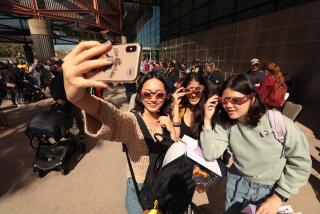SHOP TALK : The Eyes Have It--in the Sun and Out : Goal is to find glasses that, through tinted coating, provide 100% ultraviolet protection. And that can take a little money or a lot.
- Share via
Never mind those April showers earlier this week. The sun has been working overtime lately in Ventura County. Nice sunny days mean jaunts to the beach, hikes in the backcountry, plenty of outdoor activity.
And plenty of exposure to the sun’s ultraviolet rays.
Unfortunately, excessive exposure has been shown to put people at risk of cataracts, retinal damage, sunburned corneas (snow blindness), mini-growths on the eye and other optic problems.
Foster Grant knows this. Vuarnet knows this. So does Ray-Ban, Giorgio Armani, Bolle and Hobie. They are all manufacturers of sunglasses--those valuable lines of defense between UVs and the old baby blues.
Last week, we contacted several local eye experts for advice on selecting sunglasses.
First on our list of questions was, simply, “Can those $12 pairs at convenience stores sufficiently protect your eyes from the sun, or does a person need to pay upward of $50 for a quality pair of sunglasses?” The answer was unanimous. A cheap pair can, indeed, provide the needed protection. But read the label before you buy.
As most people are aware, the goal is to find sunglasses that, through a tinted coating, provide 100% UV protection. And you can find that protection for a little money or a lot of money.
“If I know I’m going to thrash my sunglasses or I’m going to the beach a lot, I’ll get some that are 100% UV protected for $10 or $12,” Oxnard optometrist Stephen Healey said. “But the cheaper brands sometimes go down to 60% or 54% protection. That’s something you’ve really got to watch out for.”
That there is a big difference between 60% protection and 100% protection is obvious. But it’s the sunglasses that provide about 97% protection that can be rather confusing. Even for the pros.
“There’s probably not a significant difference between 97% and 100%,” Healey said. “It’s very subjective. You’re going to get a different answer from whomever you ask.”
Douglas Barolsky, a Newbury Park optometrist, agreed about the disagreement.
“The difference between 93% or 97% protection and 100% protection is probably not as serious as some people think,” he said. “It really depends on your lifestyle. If you’re going to spend 10 hours a day at the beach all weekend, all summer, it would be nice to have 100%. If you’re just driving back and forth to work six days a week, it’s not much of a problem.”
Although UV protection is critical in terms of eye health, it has little to do with the cost of sunglasses. The real difference between a cheap pair and an expensive pair is the lens quality and the frame.
First, a little about lenses. The basic lens types are plastic, glass and polycarbonate. Generally speaking, the higher the price, the clearer the image. But all have their pluses and minuses.
“The polycarbonate lens is impact-resistant, but it has some peripheral distortion,” said Sharon Gil of the Ojai Valley Optometric Group. “Glass is more durable in that it doesn’t scratch, but it is heavier.”
Glass is also more breakable. Healey said plastic lenses are 15 times stronger than glass and polycarbonate lenses are 60 times stronger than glass.
“If people are buying sunglasses for laying on the beach, glass is great,” he said. “But if you’re going to use them for something active, where there is a lot of movement or something might hit them, you should seriously think about plastic or polycarbonate.”
Another option is polarized lenses, often used by fishermen and others in high-glare environments. “They are typically the more expensive, upper-end lenses,” Healey said. “The Hobie line is all polarized, for $60 to $160.”
Healey said polarized clip-ons are available for about $15. Or you can polarize a regular pair of glasses for about $70 to $100.
Now, before we go, a few words about sunglass frames--actually the biggest factor in price difference, even though they don’t directly affect the eye.
Barolsky said the more expensive frames may have spring hinges, better solder points and better plating on the metal. They are likely to fit well and stay in adjustment longer, not discolor, and have higher quality coating and tinting.
Unfortunately, they can still break if you sit on them.
More to Read
Sign up for The Wild
We’ll help you find the best places to hike, bike and run, as well as the perfect silent spots for meditation and yoga.
You may occasionally receive promotional content from the Los Angeles Times.






